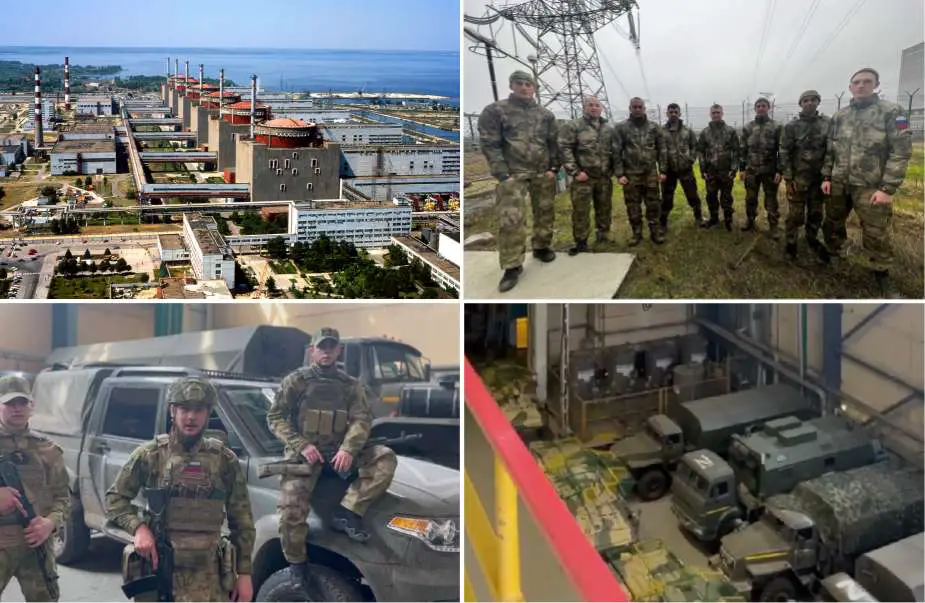- Army
- Conflicts in the world
- Israel - Iran conflict 2025
- Pakistan - India Conflict 2025
- Russia Ukraine War 2022
- Libya conflict day by day
- HAMAS - Israel War 2023
- Operation Serval in Mali French Army
- Sangaris operation Central African Republic
- Sangaris opération militaire République Centreafrique
- Ukraine - Russia conflict
- Syria conflict news
- Defence & Security Industry Technology
- Armies in the world
- Analysis Defense and Security Industry
- Conflicts in the world
- Navy
- Air
Russian Forces Transform Europe's Largest Zaporizhzhya Nuclear Facility into a Military Base
According to information published on PS01 X (Twitter) account on March 15, 2024, recently released footage by Russian soldiers from inside the Zaporizhzhya Nuclear Power Plant (ZNPP), which is currently under their control, further confirms reports that the facility is being utilized as a military base. The footage depicts armored vehicles and Russian military personnel conducting exercises, with established fire points visible in the windows of the nuclear plant.
Follow Army Recognition on Google News at this link

Several videos and photographs seem to show that Russia is taking advantage of the special status of the Zaporizhzhia nuclear power plant to convert it into a military base. (Picture source: Twitter and Russian media)
The video shows several military vehicles stationed inside a power unit of Europe's largest nuclear power plant. In the video, five Ural and KamAZ trucks are visible, alongside a vehicle resembling a command and staff car, surrounded by three BTR-80 armored personnel carriers equipped with anti-drone nets. It has been reported that around 500 Russian soldiers, along with military equipment including armored personnel carriers, anti-aircraft guns, and radiochemical reconnaissance equipment, are stationed within the station's territory. Furthermore, pictures shared by Russian military personnel indicate that the Russian Army is utilizing the Zaporizhzhya Nuclear Power Plant (ZNPP) as a military depot for equipment, including possible anti-tank guided missiles (ATGMs) launchers and UAZ Patriot pickup trucks, likely employed for transporting said equipment.
This isn't the first occasion of the ZNPP being repurposed for military use, as it was taken over by Russian forces in March 2022 shortly after the commencement of the full-scale invasion of Ukraine. Reports from August 2022 by journalists from The Insider detailed Russian military trucks entering the NPP premises and unloading unidentified cargo. The footage showed the vehicles positioned between the facility's first and second power units, with part of the convoy later seen entering the engine room of the first power unit through the cargo gate.
Satellite images released by the British Ministry of Defense in March 2023 showed Russian defensive positions, including sandbag emplacements, on the roofs of several of the ZNPP's six reactor buildings. These installations suggest the incorporation of the reactor buildings into the Russian military's defense strategy, potentially in anticipation of actions by Ukrainian forces, as seen previously at Chernobyl.
The Russian military's decision to use the Zaporizhzhia Nuclear Power Plant (ZNPP) as a military facility can be viewed from various strategic perspectives, especially within the context of international laws related to warfare. Firstly, nuclear power plants like ZNPP benefit from inherent protection under international humanitarian law due to the significant risks associated with their potential damage. This inherent safeguard might make ZNPP an attractive site for military use, providing a degree of protection against direct attacks due to the potential for widespread disaster, thus offering a form of refuge for military personnel and equipment.
While these laws are primarily intended to protect such facilities to safeguard civilian populations and the environment, they inadvertently offer a strategic advantage if a military force chooses to operate within or around these premises. For Russia, transforming a nuclear power plant into a military base might provide logistical advantages, particularly in terms of energy supply, as international law restricts attacks on nuclear facilities to prevent environmental and humanitarian disasters. These restrictions create a complex situation for the Ukrainian Armed Forces, who must navigate the legal and ethical implications of responding to military activities originating from such sites.
Furthermore, while the Additional Protocols to the Geneva Conventions generally prohibit attacks on nuclear facilities, they allow for some exceptions. These include situations where a plant directly contributes to military operations and no viable alternatives are available to stop this support. However, any military action must adhere to the principles of proportionality and minimize civilian harm, especially near nuclear power plants.
Despite their potential military use, these facilities cannot be lawfully targeted if an attack could lead to the release of radioactive materials and result in severe civilian casualties. The guidelines also discourage positioning military objectives near or within nuclear power plants to prevent these locations from becoming inadvertent military targets. Attacking nuclear facilities under certain conditions could be considered a war crime due to the potential for widespread harm, as outlined under international humanitarian law. Therefore, Russian forces may perceive the occupation and utilization of such facilities as a strategic maneuver that complicates Ukrainian military responses, primarily due to the severe risks associated with their damage or destruction.


























